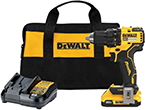Choosing the Right Compact Fluorescent Lights
Most, if not all, compact fluorescent lights (CFLs) are now equipped with a screw-in feature, so that replacing incandescent bulbs with CFLs is entirely possible. Yet, sometimes it's confusing as to which type of CFL to purchase for home use, since it seems as if there are many from which to choose. There are four main characteristics to consider when choosing CFLs for your home lamps, and they are wattage, light output, type, and color quality.
- Wattage. If you are satisfied with that 60-watt incandescent bulb in your living room lamp, and the 75-watt incandescent bulb in your reading lamp, then use the following simple equivalents to choose the correct CFL wattage for your current wattages: Trade a 40-watt incandescent for 9- to 11-watts of CFL; trade a 60-watt incandescent for 13 to 16 watts of CFL; and trade a 75-watt incandescent for 18- to 20-watts of CFL.
- Light Output. The ratio of CFL to incandescent light output is 1 to 3. For example, that 60-watt incandescent bulb is replaced by a 13- to 15-watt CFL. These ratios are typically listed on CFL packages now.
- Type. For use in regular light sockets in your home, you will need to purchase standard screw-in type CFLs with integral ballasts. There are many online sites dedicated to the types of CFLs you can choose for your home, based on your individual preferences and needs.
- Color. CFLs can mimic the colors of incandescent bulbs, in that you may choose from natural or daylight, cool or bright, and warm or soft white lighting. The overall quality of light is measured in Kelvin degrees (K).
When it comes to choosing the color for your CFLs, follow this short guide to choose the correct color temperature to suit your needs:
- Bright or cool light; choose 4,100K or higher color temperatures. Their descriptions may be bright white, cool, or natural.
- Warm or soft white; choose 2,700K to 3,000K for a warm glow such as that of an incandescent bulb. These are sometimes described as soft white.
- Natural, daylight, or very light; choose full spectrum bulbs since they tend to mimic full sunlight, such as what you would want for a reading lamp.
Speak with a qualified professional at your local home improvement or hardware store, and he can point you in the right direction when it comes to choosing the correct CFL. Make sure that you describe your preferences in lumens and color, so that you attain the desired outcome.
Author Bio
April Reinhardt
An administrator for a mutual fund management firm, April deals with the written word daily. She loves to write and plans to author a memoir in the near future. April attended Morehead State University to pursue a BA degree in Elementary Education. Learn more about April...
Cleaning Your Laptop Computer
If your laptop is over a year old, and you notice that it isn't running well or makes loud noises, then it may be time to ...
Discover More
Mulching Trees
One of the most beneficial tasks a person can do for the health of a tree is to mulch it properly. Not only can mulch ...
Discover More
Conserving Energy Around the Home
Taking small measures to conserve energy around your home can add up to big savings annually, not to mention the help ...
Discover More
More Home Improvement Tips
Installing Roof Vents
The best way to get the most out of your roofing insulation is to actually provide proper circulation for the air. ...
Discover More
Choosing Insulation
Insulation is one of the best ways possible to help make your home comfortable. Not only does insulation help heat your ...
Discover More
Choosing Energy Efficient Light Bulbs
It is becoming more and more popular to make the home as energy efficient as possible. One of the more common methods ...
Discover More

Comments